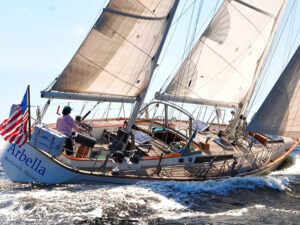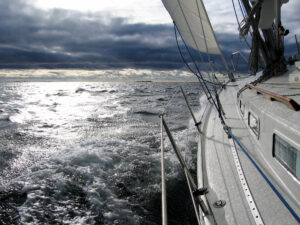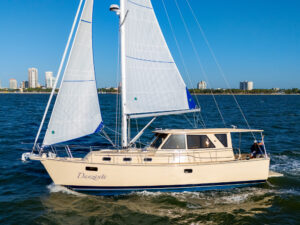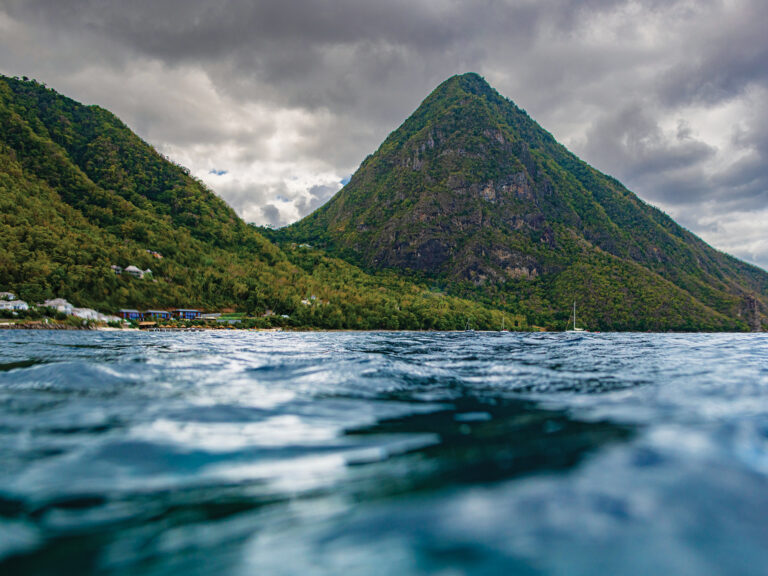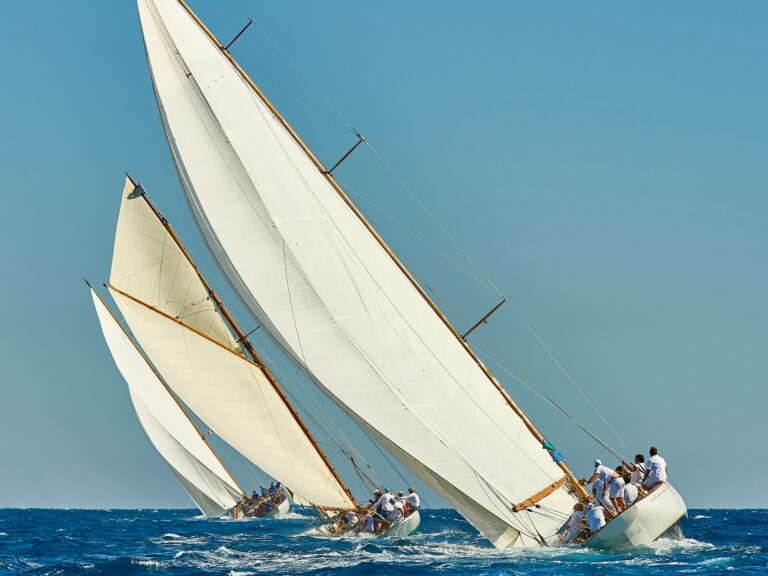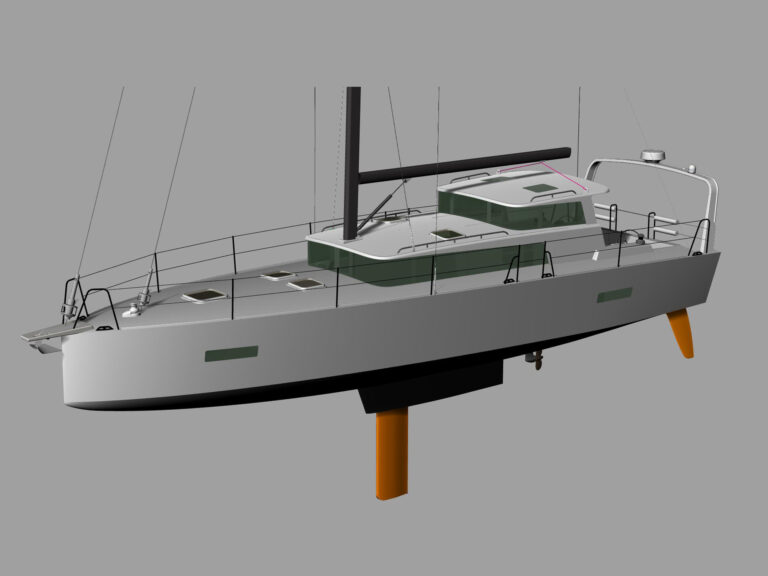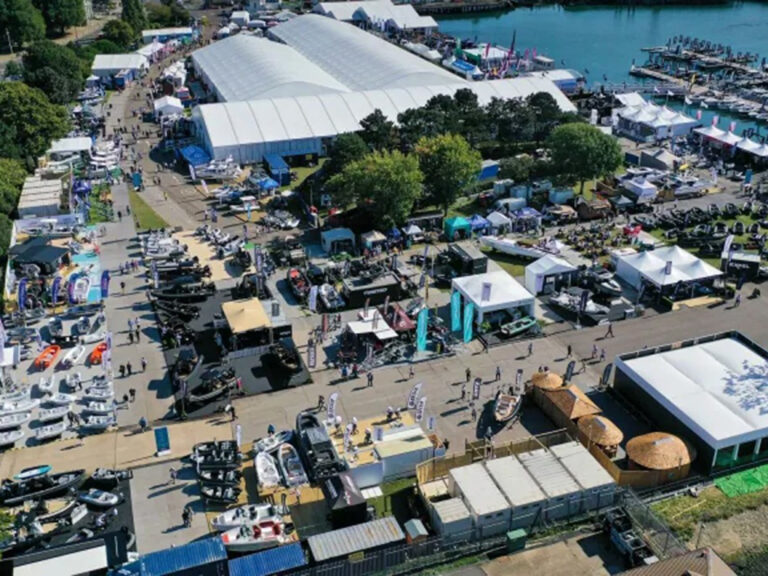
The Lesser Antilles, on the eastern rim of the Caribbean Sea, is perhaps the finest watery hideaway for boaters on our planet. It’s impossible to exaggerate the magnificence of this sailors’ paradise. It is as if God and Walt Disney conspired to design the perfect cruising ground: perfect wind, perfect seas and, most of all, perfect harbors.
And if all that weren’t enough, these harbors are also inhabited by joyous folks with wide smiles. The Caribbean is especially attractive for sailors who like to party—who desire to spend a decade or two hard aground on the mahogany reef.
From a scientific perspective, the key to understanding this area is plates. The plates are tectonic. They bump into each other, stimulating partial melting of the plates above the subduction zone. These collisions result in arcs of volcanoes. In the Lesser Antilles, this happens at regular 40-mile intervals.
I was confused about this when I arrived in the Antilles in the 1970s. That was, until I purchased a few cases of rum (at 82 cents a bottle) and met up with some farmers tending to their spices and herbs. Thus armed, I began exploring the islands from Culebra to Trinidad.
Here’s what happens: Pressure builds and builds and builds until the pressure in the earth’s core is so great that it blows a hole along the crust of the tectonic plates. That’s when lava, which is boiling molten rock, flows out. If there’s enough lava, it forms a mountain.
Often, mountains are pretty. And sloping mountains offer numerous advantages, not the least of which are regular rainfall and a calm lee to anchor behind.
After an island is formed and few million years go by, the pressure builds again, and it blows a new hole along the same fault line. The happy result in the Lesser Antilles is an arc of islands running north-south that are a perfect daysail apart.
From Anguilla to Grenada, a boater can awake, take two aspirin, have a beer for breakfast, and beam reach to the next island in daylight—with enough time to anchor, clear in, and be on barstool number one in time for happy hour. At least that’s how I arranged my cruising schedule for nearly three decades.
Sadly, paradise isn’t perfect. In terms of weather, the eastern Caribbean is almost perfect, except for the two or three days a year when passing hurricanes attempt to kill you.
This is why our fourth vessel was called Wild Card. On September 17, 1989, Hurricane Hugo blew away the entire deck of cards we’d been playing with, along with our beloved self-built 36-foot Carlotta.
But all things must come to an end, and every dark cloud has a silver lining.
Take the story of 28-year-old Ludger Sylbaris, for example. He was born in the fishing village of Le Prêcheur, Martinique, in 1874. By the turn of the previous century, he’d moved to Saint-Pierre and begun to party. Now, we’re not exactly sure what he did to get thrown in jail, only that it must have been bad. They put him in a dungeon and forced him into solitary confinement in a tiny, fortified cell whose only ventilation was a grate facing away from the mountain.
Saint-Pierre was a bustling city at the time, nicknamed the “Paris of the Caribbean.” It was scheduled to have an election in a few days, so the city’s leaders didn’t want to evacuate the town just because the local mountain was acting a bit steamed.
On May 8, 1902, at 7:52 a.m., a sailing ship had just left the waterfront and hoisted sail. Its crew glanced astern toward the shore, and the mountain blew, darkening the sky 50 miles in every direction. Between 28,000 and 30,000 souls were burned or suffocated. A few survived on the sailing ship, which proceeded to Fort-de-France to sound the alarm.
It took four days for rescuers to arrive, but there was no one to save. Except for Ludger Sylbaris. After he was freed and asked what he was in jail for, he muttered something about parking tickets or whatever. He was, in any case, promptly pardoned by the local judiciary.
Yes, the Caribbean can be capricious.
One of our favorite stops was Plymouth on the island of Montserrat. That island was known as the “Emerald Isle” back in the day. The local rum shops on the beach had chalk signs out front that counted down the days until the next St. Patrick’s Day. The reason we liked this anchorage so much was threefold: 1) It wasn’t on the way to anywhere; 2) the harbor was rolly; and 3) because of the Beatles.
We search out rolly harbors in popular cruising grounds because their anchorages are almost always deserted. In Montserrat, we hung with the crowd at the Agouti bar, unless producer George Martin of Beatles fame had someone recording. In that case, Mick Jagger, Jimmy Buffett, Sting, Mark Knopfler or Eric Clapton would sit in with the local reggae band until the wee hours.
I mean, where better for Buffett to record his album Volcano?
The quaint town itself was delightful, as were its 4,000 inhabitants. It was impossible to get into trouble in Plymouth, where all the locals seemed totally blissed out. If a too-frisky yachtie overindulged in rum (“Rum is food” was our youthful motto) and started punching locals, the big fellas would take the first few blows with a puzzled smile, and then tie up the yachtie and return him to his vessel.
Fishermen would toss still-flopping grouper on our deck without being asked, or offer to sell us conch or lobster for pennies a pound.
Then, in July 1995, the Soufrière Hills volcano sent pyroclastic flows and ash across much of the island. By August 1997, the entire town of Plymouth was buried under ash, with only the tops of telephone poles and the red roofs of its tallest buildings showing. It was as eerie as it was sad, like an abandoned production set from an old Twilight Zone television episode.
It’s impossible to exaggerate the magnificence of this sailors’ paradise. It is as if God and Walt Disney conspired to design the perfect cruising ground.
Each year, we’d sail in the lee of forbidden Plymouth during our passages south to avoid hurricane season. The silence would be deafening, especially with our regretful hearts straining to hear the once-vibrant reggae beat from the now-buried Agouti rum shop.
Here’s a truism: The two best times to visit the Caribbean are yesterday and today. We went for a single season of high-wind sailing and stayed decades because of the joy. Nearly all of our 63 years of cruising have been spent in the tropics amid this best quality of life.
Oh, the tales I could tell about a young, randy Foxy Callwood of Jost Van Dyke. Or the wild and crazy crew of Richardson’s Rigging on Tortola. Or Basil and his pretty boys of the Bitter End on Virgin Gorda. And where would sailors of the Lesser Antilles be without Tom Gerker of Parts and Power, or Charlie Cary of The Moorings in the Virgins, or Robbie Ferron and Bobby Velasquez on St. Maarten?
What rum shop other than Le Select on St. Barts would be successfully managed by a cute 14-year-old named Fast Eddie? We used to call the port of Gustavia “Star Harbor” because Bob Dylan, Harrison Ford and Raquel Welch were often seen wandering its narrow streets.
Red Hook on St. Thomas was a nest of crazy sailors. Just to the west in French Town was Dick Avery—too busy building a monorail shipyard to notice that he’d invented bareboating.
And surely there has never been a more famous, more unabashed nudist in the Lesser Antilles then Joel Byerley, skipper of Lord Jim, which was usually anchored in English Harbour, Antigua. Desmond Nicholson’s family brought English Harbour back to life.
Just the salt-kissed ink-slingers were amazing. Carleton Mitchell of the deep-draft schooner Caribee and the centerboard S&S yawl Finisterre wrote Passages East and Isles of the Caribbees, and won the Newport Bermuda Race three times in a row. Sailor Dudley Pope wrote the Lord Ramage series of novels and used to hang in St. Maarten’s Philipsburg harbor. Fritz Seyfarth, an early mentor of mine and author of Tales of the Caribbean, left his literary mark on Marina Cay in the British Virgin Islands. That’s after Robb White’s book Two on the Isle was written about the same sand spit. (The movie starred Sidney Poitier.)
No history of sailing would be complete without mentioning gymnast, ocean-racer and rum-worshiper Rudy Thompson. He not only would put a trampoline on wheels during St. Thomas carnival to do drunken flips over the live electrical wires in downtown Charlotte Amalie, but he also chartered his boat to Nobel Prize winner John Steinbeck.
Just imagine how many more I could name if my short-term memory hadn’t been so ruthlessly abused.
Yes, the Caribbean is truly a movable feast—an unstoppable sailors’ party—and the best time to go is still right now.

